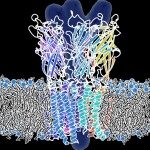Lien vers Pubmed [PMID] – 26854368
Lien vers HAL – Cliquez ici
Lien DOI – 10.1016/j.toxicon.2016.02.002
Toxicon. 2016 Jun 15;116:63-71.
Neurotoxic phospholipases A2 (sPLA2) from snake venoms interact with various protein targets with high specificity and potency. They regulate function of multiple receptors or channels essential to life processes including neuronal or neuromuscular chemoelectric signal transduction. These toxic sPLA2 exhibit high pharmacological potential and determination of PLA2-receptor binding sites represents challenging part in the receptor-channel biochemistry and pharmacology. To investigate the mechanism of interaction of neurotoxic PLA2 with its neuronal receptor at the molecular level, we used as a model crotoxin, a heterodimeric sPLA2 from rattlesnake venom and proton-gated ion channel GLIC, a bacterial homolog of pentameric ligand-gated ion channels. The three-dimensional structures of both partners, crotoxin and GLIC have been solved by X-ray crystallography and production of full-length pentameric GLIC (with ECD and TM domains) is well established. In the present study, for the first time, we demonstrated physical and functional interaction of full-length purified and solubilized GLIC with CB, (PLA2 subunit of crotoxin). We identified GLIC as a new protein target of CB and CB as a new ligand of GLIC, and showed that this non covalent interaction (PLA2-GLIC) involves the extracellular domain of GLIC. We also determined a novel function of CB as an inhibitor of proton-gated ion channel activity. In agreement with conformational changes observed upon formation of the complex, CB appears to be negative allosteric modulator (NAM) of GLIC. Finally, we proposed a possible stoichiometric model for CB – GLIC interaction based on analytical ultracentrifugation.

